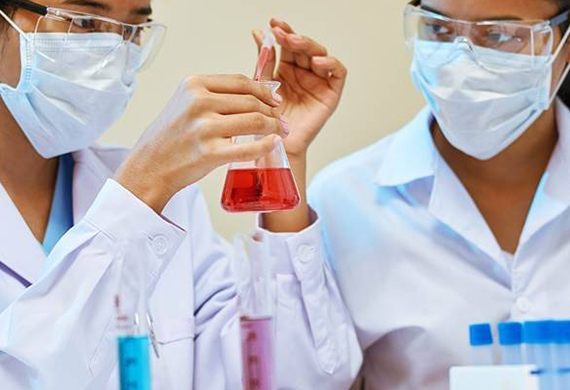
More Indian Women Graduate in STEM than US, UK & Other Western Countries
By: WE Staff
The percentage of women graduates in Science, Technology, Engineering, and Mathematics (STEM) at the tertiary level in India is higher than in developed countries such as the United States, United Kingdom, Germany, and France, according to data presented to the LokSabha recently. Union Education Minister Dharmendra Pradhan provided the information in response to a written question.
While the female share of STEM graduates in India was 42.72 percent in 2016, the United States had 33.99 percent, Germany had 27.14 percent, the United Kingdom had 38.10 percent, France had 31.81 percent, and Canada had 31.43 percent.
The trend continued in 2017 and 2018, with 43.93 and 42.73 percent of women in STEM in India, respectively.
In response to a question about the number of STEM graduates over the last three years and whether there are more men than women in STEM, Pradhan shared All India Survey on Higher Education (AISHE) data from the previous three years, which revealed that while the number of men decreased from 12.48 lakh in 2017-18 to 11.88 lakh in 2019-20, the number of women increased from 10 lakh to 10.56 lakh during the same period.
The government, through the Department of Science and Technology, has taken a number of steps to increase women's participation in STEM for higher education. This includes the implementation of women-only programmes such as 'Knowledge Involvement Research Advancement through Nurturing (KIRAN)' to encourage women to pursue careers in science and technology.
"The 'mobility' programme has been introduced to address relocation issue of working women scientists. Further 'Indo-US Fellowship for Women in STEMM' (Science, Technology, Engineering, Mathematics and Medicine) was launched to provide opportunities to Indian women scientists, engineers and technologists to undertake international collaborative research in premier institutions in the US for duration of 3-6 months," Pradhan said."The Consolidation of University Research through Innovation and Excellence in Women Universities (CURIE) provides support to develop research infrastructure and state-of-the-art research facilities in women universities and to help enhancing women's participation in research and development activities in science and technology domain."
The minister also shared World Bank data showing that, at least until 2016, more Indian women graduated in STEM than in the United States, United Kingdom, Germany, and France, among others.
As of September 30, 2019, the report includes data on student enrollment, examination results, "education finance," pupil-teacher ratios, and infrastructure. The survey includes 1,019 universities, 39,955 colleges, and 9,599 ‘stand-alone institutions' (which run diploma-level programmes but do not offer degrees).
307 of these are ‘affiliating' (or have colleges), 396 are privately managed, and 420 are located in rural areas.
According to survey results, there are more than 38.5 million students enrolled in higher education as of September 30, 2019. 79.5 percent (30.6 million students) are enrolled in undergraduate degree programmes, 11.2 percent (4.3 million students) are enrolled in post-graduate programmes, and the rest are enrolled in diploma courses, post-graduate diploma courses, certificate courses, and other courses, MPhil courses and for PhDs.
Approximately 51,000 students are pursuing PhDs in the sciences. Chemistry has the most PhD candidates, with 9,526 total, including 5,554 men and 3,972 women. This is followed by 7,439 (4,632 male and 2,807 female) physics students and 5,284 (2,360 male and 2,924 female) mathematics students.
51% of the 38.5 million students enrolled in higher education are female, while 49% are male. Around 14.7% of students are from Scheduled Castes (SCs), 5.6% are from Scheduled Tribes (STs), and 37% are from Other Backward Classes (OBCs).
According to AISHE 2019-20, there are 49,348 foreign nationals enrolled in higher education in India from 168 different countries. Nepal has the highest proportion (28.1%), followed by Afghanistan (9.1%), Bangladesh (4.6%), and Bhutan (3.8 per cent).
In 2019, 20.3 lakh people graduated from undergraduate programmes in the arts or humanities, 10.8 lakh in science, and 9.3 lakh in commerce. Approximately 8.2 lakh students graduated with degrees in engineering or technology, while 2.38 lakh studied medicine.
Women make up 42.5 percent of the 1.5 million teachers surveyed in 2019-20, with men accounting for the remainder. The majority of teachers (56.5%) are from the general category, with 32.1 percent from OBCs, 9% from SCs, 2.4% from STs, 5.6 percent from Muslims, and 9% from other minority communities.
Female enrollment has increased from 86 per 100 males in 2015-16 to 96 per 100 males in 2019-20.
From 2015-16 to 2019-20, the Gender Parity Index for Higher Education – the ratio of female to male students in higher education – increased from 92 to 101 female students for 100 males. During the same time period, it increased from 91 to 105 females for every 100 males in the SCs and from 83 to 97 females for every 100 males in the STs.
Female enrollment in MA, MSc, and M. Com programmes has increased dramatically in the last five years. However, their participation in undergraduate programmes such as BBA, B. Tech, and LLB remains low.
Most Viewed
- 1 Women's Health Startup HerMD Closing Doors Amid Industry Challenges
- 2 5 Famous Women in Indian Armed Forces
- 3 Saudi Women No longer Require Male Permission for Clothing Choices, says Prince MbS
- 4 Kolkata Medtech Startup Innovodigm Raises Rs 5.5 Crore Seed Funding Led by IAN Group
- 5 Yamunanagar's Kashish Kalra Honoured after Securing 111th Rank in UPSC Civil Services Exam
- 6 Madurai Appoints Its First Woman Corporation Head
- 7 IAS Vijayalakshmi Bidari Appointed as the new Nagpur Divisional Commissioner
- 8 American Entrepreneur Lucy Guo Overtakes T Swift to become Youngest Female Billionaire
- 9 ICC Women's World Cup 2025 Trophy Showcased at Indore's Holkar Stadium
- 10 Aparna Saxena's Beauty Venture AntiNorm Launches in India
- 11 Vidya Nataraj Co-Founded BlueStone Jewellery & Lifestyle files IPO
- 12 5 Women Freedom Fighters of India
- 13 Dr. G Krishnapriya appointed as CEO for Trichy
- 14 M3M & Sirona Partner to Introduce Menstrual Hygiene Vending Machines in 15 Locations
- 15 Punjab Govt launches SHE Cohort 3.0 Supporting Tech-led Women Startups
- 16 Indian origin Lawyer, Sweena Pannu appointed as the US New Superior Court Judge
- 17 The Aurora Tech Award recognizes 4 Indian Women-led Startups
- 18 Kerala's Republic Day parade featured an all-female tableau
- 19 Manisha Kabbur Becomes Karnataka's First Woman International Karate Coach
- 20 Director K. S. Ravikumar's Daughter Maalica Ravikumar Launches Life Coaching Company 'Evergrowth Academy' for Women
- 21 Leezu's Raises Pre-Seed Funding to Accelerate Growth in Sexual Wellness Industry
- 22 Sattu: Super-easy summer drink for PCOS gut healing
- 23 Swathi Nelabhatla creates Sitha App, India's First Women-Exclusive Gig Platform
- 24 7 Timeless Female Kathak Dancers & their Iconic Legacies
- 25 Meet 7 Iconic Women Architects of Modern India & their Most Impactful Work
- 26 This Woman-led Insuretech Startup is Helping Bridge the Education Financing Gap in India
- 27 Women Leaders Share Lessons Learnt from India Women's WC Win
- 28 5 Enterprising Women Founders Powering Singapore's Tech & Innovation Landscape
- 29 4 Women. 4 Stories. One Vision for Smarter, Stronger Healthcare
- 30 Global Gender Gap Narrows to 68.8%, But Full Equality 123 Years Away: WEF Report 2025
- 31 Changemakers: 7 Women Entrepreneurs Taking the Make in India Movement Forward
- 32 Meet Lucy Guo, The Youngest Self-Made Female Billionaire Disrupting Tech
- 33 How Women are Driving India's Festive Online Shopping Surge






